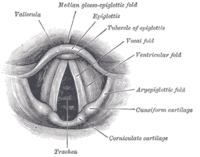
Photo from wikipedia
In this article, the spread of breathing air when playing wind instruments and singing was investigated and visualized using two methods: (1) schlieren imaging with a schlieren mirror and (2)… Click to show full abstract
In this article, the spread of breathing air when playing wind instruments and singing was investigated and visualized using two methods: (1) schlieren imaging with a schlieren mirror and (2) background-oriented schlieren (BOS). These methods visualize airflow by visualizing density gradients in transparent media. The playing of professional woodwind and brass instrument players, as well as professional classical trained singers, were investigated to estimate the spread distances of the breathing air. For a better comparison and consistent measurement series, a single high and a single low note as well as an extract of a musical piece were investigated. Additionally, anemometry was used to determine the velocity of the spreading breathing air and the extent to which it was still quantifiable. The results presented in this article show there is no airflow escaping from the instruments, which is transported farther than 1.2 m into the room. However, differences in the various instruments have to be considered to assess properly the spread of the breathing air. The findings discussed below help to estimate the risk of cross-infection for wind instrument players and singers and to develop efficacious safety precautions, which is essential during critical health periods such as the current COVID-19 pandemic.
Journal Title: Indoor air
Year Published: 2021
Link to full text (if available)
Share on Social Media: Sign Up to like & get
recommendations!